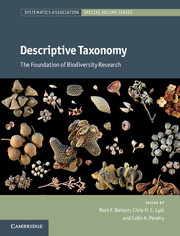Descriptive Taxonomy: The Foundation of Biodiversity Research
 Mark F Watson, Chris H C Lyal and Colin Pendry (eds)
Mark F Watson, Chris H C Lyal and Colin Pendry (eds)
Cambridge University Press, £65.00
Once viewed as a discipline at the dry and dusty end of biology, taxonomy has had a rebirth in recent years, placing it firmly in the scientific limelight.
This revolution has come about as a result of different forces. These are scientific, with the rise of DNA phylogenies and the computer power to process large data sets. Arguably more important is the rise of digital technologies taking taxonomy to the people. Meanwhile, there is also the realisation that biodiversity is fast disappearing.
These developments have fuelled innovation in making taxonomic information readily available. This book is an attempt to bring together researchers from a wide range of taxonomic fields (plants, fungi, plankton and animals all feature) and get them to share their experience and expertise in making taxonomy as accessible as possible to a wide audience.
As with any such multi-authored and multi-kingdom book, not all sections will be relevant to everyone. Nevertheless, there is much of interest. I particularly enjoyed Sandra Knapp's piece on the changing roles of collections and field research, while Eliécer Gutiérrez's account of the field identification of vectors and pathogens of military significance gave me a new perspective on the value of identification.
A recommended text for those working in taxonomy and searching for an accessible update on current practices.


